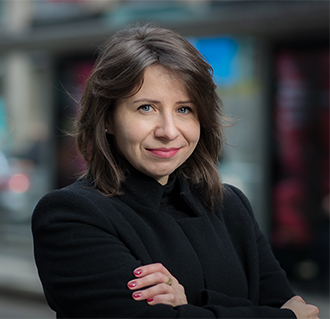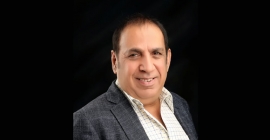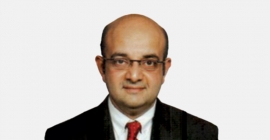‘Programmatic OOH is not here to replace traditional OOH, but to complement it’
By Rajiv Raghunath - February 14, 2022
Dorota Karc, Head of Programmatic, WallDecaux provides a detailed outlook on programmatic OOH in an interview with Rajiv Raghunath. With over 10 years of experience in global online marketing, Dorota gained special expertise in programmatic, data and cross-channel technologies while working in different positions for digital marketing agency spacedealer, data provider Eyeota, Zalando and UEFA.
 Initially, many felt that programmatic will not work for a medium like OOH/DOOH that is ‘one to many’. However, programmatic now figures prominently in OOH industry discussions. What factors are contributing to wider OOH industry acceptance of programmatic OOH/DOOH?
Initially, many felt that programmatic will not work for a medium like OOH/DOOH that is ‘one to many’. However, programmatic now figures prominently in OOH industry discussions. What factors are contributing to wider OOH industry acceptance of programmatic OOH/DOOH?
There are two perspectives to consider when answering this question. First, programmatic becoming part of the OOH ecosystem, and secondly OOH becoming part of programmatic ecosysystem.
OOH becoming a part of programmatic ecosystem is a realisation of every CMO’s goal – being able to book and track online and offline omnichannel campaigns through a unified tech stack. Offline channels becoming part of programmatic thanks to CTV, Audio and OOH are enabling this. 24% of the interviewees in the JCDecaux Programmatic Study highlighted that omnichannel approach is one of the reasons why they implement or consider implementing Programmatic OOH.
Strategically a brand would like to have under its control on all media buying and with OOH becoming part of programmatic, we give our clients more control and more flexibility in buying our inventory, which would not be possible in traditional OOH. Programmatic OOH is not here to replace traditional OOH, but to complement it, and gives a chance for more flexibility, as well as diversification of OOH buying strategy.
The OOH industry accepting programmatic is a natural development and given the fact that as a media owner we need to serve our client’s needs, if the CMOs need more omnichannel tech stack, then programmatic is a natural development towards this direction. OOH is not anymore only a broadcast medium; it is moving down the funnel and this development would not be possible without programmatic.
In my observation, the OOH industry approaches programmatic with a blend of excitement and / or fear. Excitement because it is related to new technologies, development, and wider activation of data. Fear is related more to the programmatic complexity, jargon and dealing with unknown.
For traditional OOH experts, who are not exposed daily to discussions about cookies, MAIDs, targeting, attribution and omnichannel technologies, this can be of course overwhelming. I felt the same while joining WallDecaux. Not having previous OOH background required from me learning about networks, D6s screens and the way contacts / OTAs are counted, which was an exciting learning curve. This obviously applies as well to any programmatic expert, who wants to book OOH in the DSP and needs to learn those OOH basics. Answer to any fear or lack of knowledge is education and transparency.
At WallDecaux, since day one we prioritised education, both internal, but also externally to clients, agencies as well as DSPs and programmatic experts. Programmatic OOH is a new industry, and this does require to develop standards and educate the market. As an example, you can find our local programmatic OOH playbook and whitepaper, which serve its educational purpose. Majority of JCDecaux entities have their own local playbooks as well. IAB globally does also do a great job launching regularly studies or whitepapers about Programmatic OOH.
Links to documents mentioned above:
Are advertisers beginning to see greater value in using OOH/DOOH channels through programmatic platforms? What has been the experience of WallDecaux in this regard?
Yes, we do observe this trend as well. There are a couple of advantages of Programmatic OOH for the clients. Firstly, the client gets more flexibility and can steer the buying and optimisation on their own in the DSP. These include, for example, time targeting, location targeting, pacing. These also give the client the opportunity to start and stop the buying whenever necessary, which in case of lockdowns was a big advantage. There is no commitment toward media owner, except for guaranteed deals, also traded in programmatic.
Secondly, the client can leverage data, being either audience data, proximity data or real-time trigger data – these can be done either by a media owner, in the SSP or directly in the DSP. The data can be used either just for targeting or for creative optimisation. Importantly, all of these can be activated for real time DCO (dynamic creative optimisation). On top of that, the client has access to unified standard of buying and this can help to optimise media planning, buying and reporting. Moreover, the client has a better possibility to bundle OOH with other channels, such as mobile or CTV. In traditional OOH there is no possibility to get a standardised media plan, not only across all OOH media owners, but also cross-channel. By DOOH joining the programmatic ecosystem that becomes a reality.
In case of JCDecaux, currently over 15 countries are enabled through our SSP VIOOH across 34 DSPs. These are countries in variety of regions: APAC, EMEA, Americas. With programmatic you do not need to talk to 15 sales representatives across 15 countries to activate buying. Instead of talking to 15 sales representatives across 15 countries, you can steer the buying on your own in one DSP. The operational efficiency is a massive advantage here and not only makes the life of a clients and agencies operationally easier, it does also help international client so streamline their process. Of course, there is still a human component as part of the PMP set up and negotiation and technically we do not offer now one unified deal id across all countries, but programmatic OOH is providing more automation. This is, of course, just the beginning, and we would surely see even more automation across the years.
Does it concern you that there is an increasing number of programmatic platforms coming up in different markets? Do you expect consolidation of business in this area?
It does not concern me, but I do question the need and the USP of every new platform coming up. Programmatic with limited tracking, GDPR regulations (in particularly strong in Europe) and with more walled gardens does lead to the number of players being reduced. I do see scope of acquisitions, not consolidation. Let’s look at the notable acquisitions in the last three months: Criteo aquired Iponweb; Microsoft bought Xandr and Activision Blizzard.
What does it mean? It means more specialised advertising. Criteo thanks to Iponweb is going to strengthen its retail proposition. Then Microsoft buying Xandr and Activision Blizzard. Microsoft wants to join GAFAS; they have to somehow differentiate, and I believe gaming advertising might be the key here.
From an end-user perspective, managing a variety of seat id across the tech stack is very challenging and gives rise to further challenges related to attribution and tracking, which acquisitions and consolidation solve.
Would you reckon that pDOOH is helping to create a robust tech ecosystem for OOH as a whole? Any particular developments that you would like to highlight in this regard?
Yes, of course. Programmatic OOH is enabling innovation for OOH, bringing more digital and tech know-how. Three specific examples: thanks to programmatic data proposition is developing, also the measurement is a piece that is still in its early phase development. From a media owner perspective also understanding our yields and scaling them thanks to auction-based buying has a significant impact on tech development.
OOH is also helping programmatic to understand better contextual targeting, which is a big opportunity for the Programmatic industry, especially given the challenge related to tracking and privacy. For example, if you look at Meta’s earning report from early February, which caused a stock exchange value drop of 26%, which is an equivalent of $251 billion in value in one day. One of the major reasons was the fact that Meta cannot make revenue on IOS users anymore. All those tracking limitations are in place since some time, and it will be leading to more and more walled gardens. This gives more space to OOH and more localised or contextual programmatic, as well as development of more one-to-many or cohort-based tracking solutions.
As a media owning firm, what factors would bring more media owning firms to test the programmatic waters?
From an OOH media owner perspective, enabling programmatic is helping us to unleash new revenue streams and drive innovation.
OOH traditionally is sold in networks, and there is less control given to brands and agencies and in some countries buying of OOH is primarily done by OOH special agencies called specialists. Programmatic OOH is democratising the way of buying OOH and allows not only for big agency groups or specialists to buy programmatic and make their offering more attractive to the clients, but also allows digital agencies, SMEs, direct clients with own tech stacks to get access to buying DOOH screen.
On top of that, programmatic brings certain development and transformation for the OOH media owner.

Stay on top of OOH media trends










